Suky Best |
.jpg) |
| 54 Morning Lane 2011 video still |
|
Suky Best is an artist based in London. Working
with print, animation and installation, she has exhibited nationally
and internationally.
|
| > Curriculum vitae |
| > Artist website |
| > Exhibitions at the gallery: 25 Years 2020, Wild Interior 2014, Wild West 2005 |
| > Editions |
| > Press |
| SELECTED WORKS |
,%202020,%20looping%20video%20with%20sound,%203m%205s.JPG)
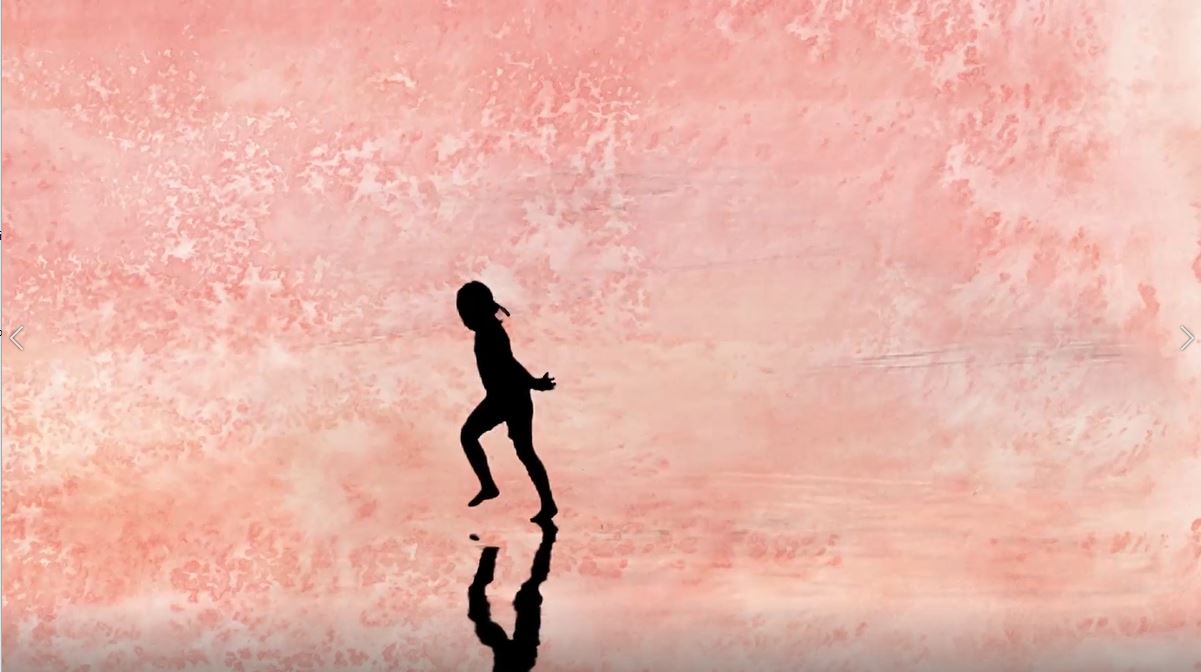 |
| Beach Studies (Kerala) |
| 2020 looping video with sound 3m 5s |
| These short
beach studies are from time spent in India (Kovalam), a seaside
resort on the southern coast of Kerala, in Jan 2019 and Jan 2020.
It was intriguing to see how differently Indian people behaved in
and out of the sea. Going in fully clothed, chatting groups lark
about, having in fun in a way that we don’t seem to in the UK. The
women unconcerned about their Saris, none caring about shoes getting
wet, these groups jostle each other, boys splashing, dunking shrieking
elders having fun. Until it’s time for the photos. For the photos
everything changes. These arranged, curated moments are serious
and intentional. Laughter stops for the moment when gazing at the
camera is all, then resumes once the image is done. Each person
has a strong idea of their ideal image, arranging themselves, giving
orders to those around them, a curated idea of the self. It wasn’t until March 2020 when we went into the coronavirus pandemic lockdown that the work began to take shape. It gave me somewhere to escape and dream of when we were barely allowed to leave our houses except for food and exercise. The child playing so freely in the surf takes us back to a freer time when we didn’t have to think about the future. Those who seem to be having the most fun, don’t have their cameras out. The surfing boys, the child covering himself in sand, they are in the moment, feeling, experiencing, enjoying. I made this work in isolated central London in March - June 2020 and it gave me comfort. - Suky Best |
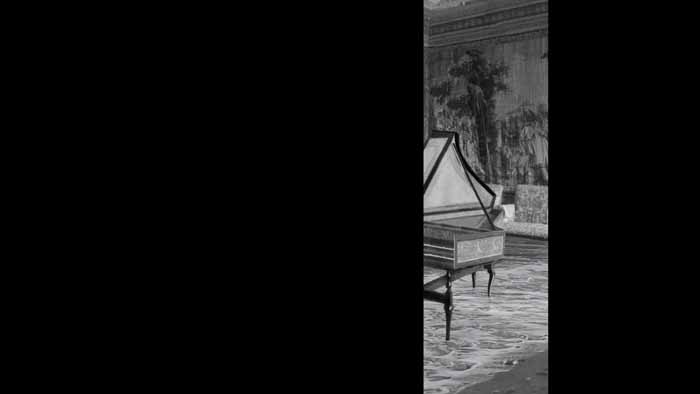
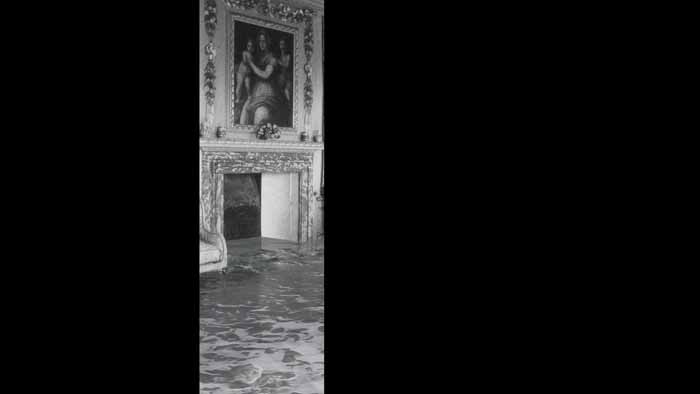 |
| The Sea House |
| 2014, Animation |
| Suky Best’s
animation, The Sea House (2014), begins as it ends; a black
screen enveloped by the sounds of the sea. The work is an animation;
images of historic interiors collaged with live footage of the sea.
Each separate interior in the animation has its own individual sea;
some swelling and crashing, others gently lapping at the carpeted
coast. At one point the sea even seems to emerge from the mouth
of a fireplace, water-logging piano legs, its wildness threatening
this man-made fragility. The work’s metronomic effect emerges not
only from the sea soundscape but from the moving slit in the image,
revealing the visual collage only in fragments, allowing us to peer
into this collaged world through a segment of a screen that is primarily
black. The obfuscation focuses our gaze on the details of the interiors;
our eyes following the slit in the screen, left to right and back
again, in the same way they might follow a hypnotist’s pendulum.
The collaging is intentionally clunky in places, adding to the surreal
nature of the work - we know the sea has not actually invaded these
rooms but can we be sure? The fact that the work is in black and
white confuses this further; we register the sea on the same visual
plane as the room’s interiors, the only clue of its fictitiousness
in the collage’s disjunctions. I watch this work on my third day of self-isolation during the quickly progressing public health crisis, COVID-19. Half an hour passes and I find that I have watched the animation on loop, four times. There is something mesmeric about it, something soothing in a time of such high-anxiety. This is partially the magic of the sea, its healing qualities effective even through the transposition of its sound into a London flat, where in confinement I could not feel further from its salty sting. It is a metronome, marking the passing of time with its tides; with the soporific rumble of its body, retreating outwards and crashing inwards - dredging up and vanishing the grit from its bed, all in the same breath. The white noise of the sea underpinning Best’s animation draws us into the work’s imagery; lulls us into a rhythmic looking. At a time when many of us are facing empty rooms, we can take comfort in this work, rocked in our homes by the work’s lulling sounds. - Tess Charnley |
.jpg)
.jpg)
.jpg) |
| At Betty's House |
| 2012, Animation |
| Suky Best
has a long-running fascination with the clash occasioned by encounters
between well-groomed domestic interiors and nature run wild.
In At Betty’s House, an environment somewhere between a room and its plan and elevation is realised. The spaces are constructed from a combination of images of real and doll’s houses. With the floor beneath carpets removed, the latter seems to take on mass, projecting assertively into the void that separates it from the viewer, and throughout the piece the removal of information, combined with the way we fly through the spaces and between objects, generates multiple ambiguities and conflicts of scale; after leaving a large room we encounter a set of coffee and tea pots, beyond which lies a group of lemons. The way these elements are disposed was inspired in part by the still lives of the seventeenth century Spanish painter Juan Sánchez de Cotán, whose invariably front or top-lit subjects: melons, cabbages, quinces, similarly hang in impenetrably dark spaces. As Betty’s pots are approached their cut-out nature becomes blatantly visible, followed by the lemons, which resolve into the matrices of their constituent colours: cyan, magenta, yellow. Thus we are shifted from one kind of seeing to another, one level of matter to another, from the image of a thing to its material constitution, in a single continuous sweep. Simultaneously our scale has shrunk from human sized to miniature as the lemons loom over us. There is perhaps a link back here to Best’s enthusiasm for cowboy iconography, in that the sensation evoked is reminiscent of the common scenario in Western movies where a group of riders passes a narrowing defile (just before the Indians attack). For Best the work ‘refers to the interior spaces of computer games and their first person point of view’, and although the piece is structured loosely round alternating views of corridors and object groupings, the whole is constructed as a continuous fly-through. The camera finds a path between all these contrasting elements, unifying everything it encounters into a sequence of surfaces to be negotiated. But this unifying process also generates the many anomalies of scale and texture that reveal the nature of the work’s construction. Here, perhaps, one might think of the way the inexperienced gamer finds himself bumping against the pixillated boundary wall of the game’s universe. But although gaming environments are often hostile and dangerous, they are never uncanny, as they are in Betty’s house, which the humans have abandoned, leaving an eerily empty scene reminiscent of that described in the story of the Mary Celeste. - Nicky Hamlyn |
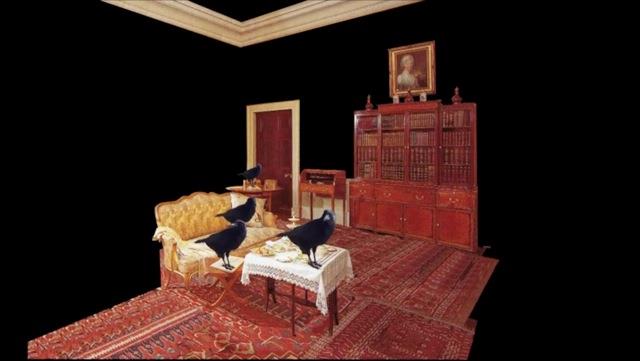
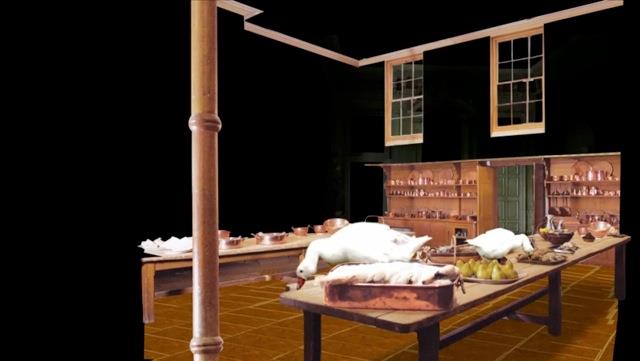 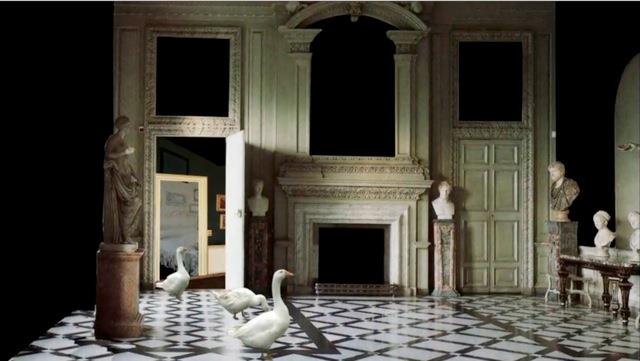
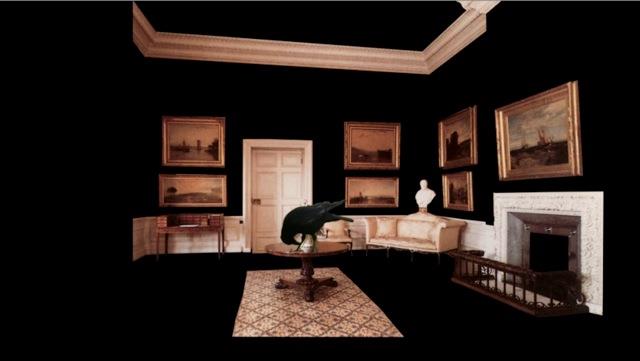 |
| Alwyn Park House |
| 2011, Animation and 3D prints |
| Alwyn
Park House, is modeled on the form of the toy theatre, with
its stack of printed cardboard flats that recede from the eye and
between which figures can emerge and disappear. The house is a composite,
constructed from stock photos of furniture and household effects
found in stately home guides. Thus the objects represented in the
film exist, but not in the configuration in which we see them here.
The walls have been removed so that the remaining furniture comes
to define the space it occupies as provisional. Doors have been
made semi-transparent (and given thickened edges, since they are
only paper-thin) in order to create a complex vista of succeeding
spaces through which a virtual camera can fly. - Nicky Hamlyn |
.jpg) |
| 54 Morning Lane |
| 2011, Animation |
| Four scenes each just over a minute long showing a collage of filmed owls placed on top of a scene from a British film of the 1940’s (This Happy Breed 1941). In each scene owls appear and disappear. The work comes from ideas of transgressive animals within children’s fiction, especially Beatrix Potter’s, A Tale of Two Bad Mice, 1902 where two mice enter a dolls house, and, finding all the food to be fake, smash it up in anger and disappointment The room, a film set, is used as a constructed fictional space, like a dolls house but for adults. The collage is deliberately crude to allow a space for the viewer to fill in the gaps and make the scene more real; what they are watching isn’t real. |
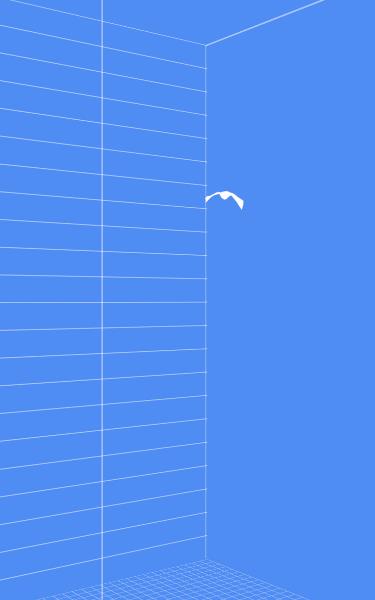
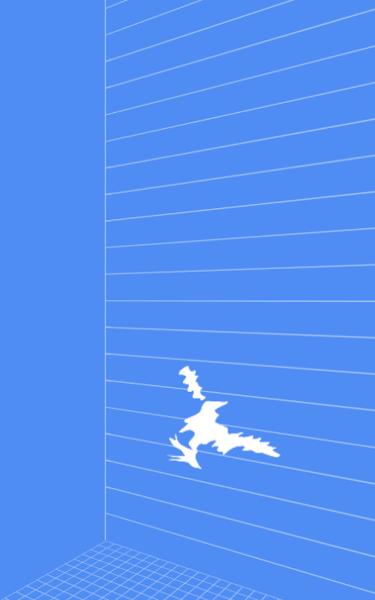 |
| An observation of Flight |
| 2010, Animation |
| In
An Observation of Flight (2010), a Peregrine Falcon’s movements,
seen in silhouette, are tracked against a rotating latticework cage
across and within which it flies. Reduced to a ragged white blur,
the bird sometimes resembles a clutch of falling leaves or even
paint dripping from a brush. The rotating grid pattern imposes a
malleable three-dimensionality that clashes with the two dimensionality
of the bird. Such clashes, or interplay, structure all the work
seen here, which can be thought of as hybrid: time-based collages
that combine non-temporal photo-reproduced elements, populated by
cutout loops of footage of real birds, energized and animated by
a virtual camera. - Nicky Hamlyn |
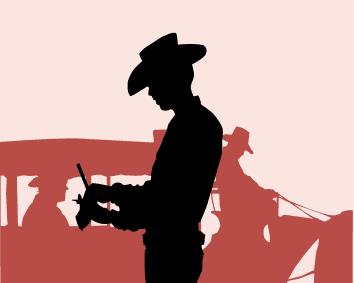
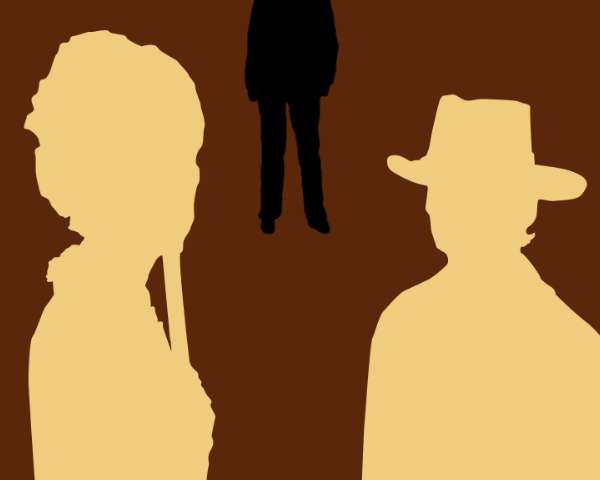
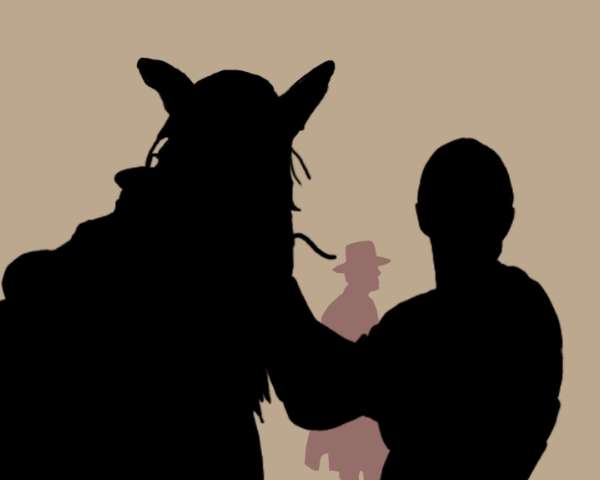 |
| Cowboy Scene |
| 2005, series of prints - collaboration with Rory Hamilton |
| Artists Suky Best and Rory Hamilton collaborated on works exploring the cowboy myth. They investigated themes of heroism and eternal narratives of the lone stranger coming to put things right before disappearing into the sunset. Flat clear silhouettes replace the dusty blur of the Wild West. In these worksonly the hero or his companion (be they horse, tracker or love interest) are transcribed onto the finished image. All extraneous detail is removed. When a cowboy ties up a horse and walks into a building, the horse and rider are boldly drawn, the building only existing when the rider walks behind a column, the cowboy defining the world around him. |
| >home |